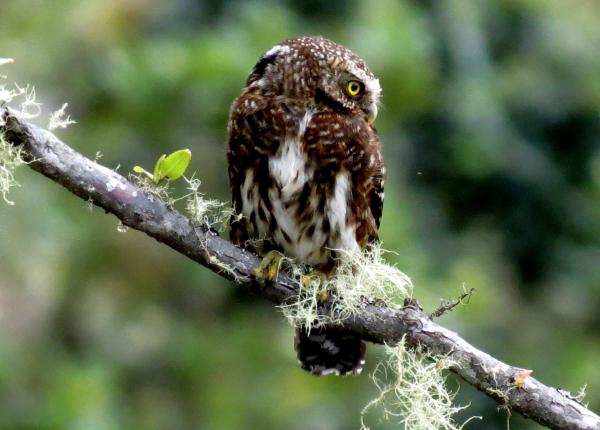Did You Know?
- The Yungas Pygmy-owl was once considered to be a subspecies of the Andean pygmy-owl (Glaucidium jardinii). But, recently, scientists have recognized it as its own species.
- This species is found at higher elevations than other Glaucidium species
How The Peregrine Fund is Helping
The Peregrine Fund is not working directly with Yungas Pygmy-owls, but our conservation efforts through habitat protection, education, and community outreach extend to all raptor species, including this owl. We also supply literature to researchers from our avian research library, which helps scientists around the world gather and share important information on raptor conservation. And, we support the Neotropical Raptor Network that promotes raptor conservation by helping create collaboration and communication among conservationists in the region.
Where They Live
The Yungas Pygmy-owl has a limited range within South America. It is found in some areas of Peru, Bolivia, and Argentina. This lovely, little owl can be found flying, hunting, perching and nesting in montane and cloud forests. It seems to prefer forests with thick undergrowth, and lots of moss and epiphytes. They are found in Podocarpus (a genus of conifer tree) forests. In Bolivia it inhabits the high elevation Polylepis forests, but is otherwise found from between 900-3,000 meters about sea level.
What They Do
The Yungas Pygmy-owl is a lovely little bird of prey. Like some other pygmy-owls individuals vary a bit in color morphs. In the case of this owl, it has three color morphs - a gray morph, a brown morph and a rufous morph. No matter which color morph an individual has, there are some plumage characteristics they all have in common. They all have light-colored spots on their heads, backs, and wings. They have "false eyes" on the backs of their heads. But what are "false eyes?" They are a combination of light and dark feathers that create a pattern that looks like eyes.
This species is crepuscular, meaning it moves around and hunts at dawn and dusk. It is also nocturnal - remaining active at night. Though it is also known to be active during daylight hours, it seems to be less diurnal than other pygmy-owls.
Why They Need our Help
The Yungas Pygmy-owl is categorized as a species of Least Concern. However, it does face some threats including deforestation. Thankfully, much of this owl's range is in areas that might be hard for humans to get to, so hopefully their habitat will remain intact for a long time to come. Sadly, this species' population does seem to be in decline.
What They Eat
Unfortunately, there is still so much we don't know about this owl's diet. We know that it feed on insects, as well as other arthropods, small birds and probably small reptiles as well. It searches for food within the canopy and in thick vegetation below the forest canopy. Apart from this, not much else is known.
Nests, Eggs, and Young
Scientists still have a lot to learn about the breeding biology and behavior of this owl. It likely nests in holes in trees created by woodpeckers. And that's pretty much all we know! How many eggs do they lay? Do both the male and female incubate the eggs? How long do the nestlings need to remain in the nest before they fly? There are so many questions waiting to be answered.
Yungas Pygmy-owl and the World Center for Birds of Prey
Though The Peregrine Fund's World Center for Birds of Prey is far away from the Yungas Pygmy-owl's habitat, a visit here will afford you the opportunity to meet a few other owl species: Rusty, our Eastern Screech-owl, and Winston, our Western Screech-owl. They are often out greeting visitors during bird presentations and sit comfortably on their handlers' gloves, which allows you to get a close up view of these exceptionally cute raptors.
Additionally, the World Center for Birds of Prey offers fun ways to learn about birds of prey. Interactive activities, tours, interesting videos and a children's room feature activities from coloring sheets to quizzes to costumes. There is also a touch table with owl feathers and other natural objects for exploration.
References:
BirdLife International. 2017. Glaucidium bolivianum (amended version of 2017 assessment). The IUCN Red List of Threatened Species 2017: e.T22689229A118857982. https://dx.doi.org/10.2305/IUCN.UK.2017-3.RLTS.T22689229A118857982.en. Downloaded on 09 September 2021.
Holt, D. W., R. Berkley, C. Deppe, P. L. Enríquez, J. L. Petersen, J. L. Rangel Salazar, K. P. Segars, K. L. Wood, and J. S. Marks (2020). Yungas Pygmy-Owl (Glaucidium bolivianum), version 1.0. In Birds of the World (J. del Hoyo, A. Elliott, J. Sargatal, D. A. Christie, and E. de Juana, Editors). Cornell Lab of Ornithology, Ithaca, NY, USA. https://doi.org/10.2173/bow.yupowl1.01









